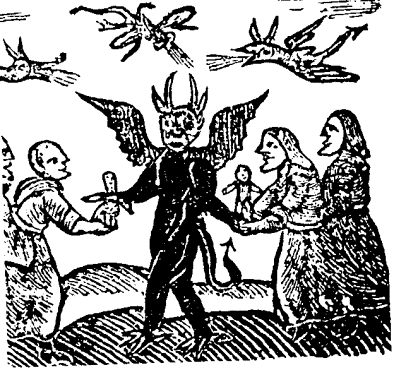The Scottish Witchcraft Trials 1563-1727
Talk by Roy Pugh 29th. October 2008
With Halloween fast approaching it was appropriate that the subject of the talk should have been “The Scottish Witchcraft Trials 1563- 1727”, a talk handsomely delivered by Mr. Roy Pugh of Dunbar, an expert on his subject and author of the book;
"The Deil’ Ain”
Witchcraft can be traced back even to biblical times justification for their persecution being the enjoinder contained in the Book of Exodus that ‘thou shalt not suffer a witch to live".
Certainly there were persecutions in the middle ages reaching new heights at the time of the Knights Templar and later with the Spanish Inquisition egged on by the work of two Dominican Friars in their book "Malleus Meleficarum" or ‘The Hammer of Witches" and with the coming of the Reformation it has been estimated that over 100,000 alone were burnt in Protestant Germany.
In Scotland the first act against witchcraft was passed in 1563, three years after the establishment of Protestantism co-incidentally (or not) the same year as in England. Although it is quite impossible to know how many witches and warlocks were put to death in Scotland the author estimated the number at something like 4500 persons (the great majority female) against only perhaps 400 in the same period in England, a very much more populous country.
The act against Witchcraft was only repealed in 1736 nine years after the last burning, Scotland being the last country in Europe to do so. However even as late as 1946 a medium one Helen Duncan was prosecuted for pretending to be a witch and suspected of passing on information to the Germans, a prosecution described by Churchill as ‘this piece of tomfoolery’.
Going back to persecutions in Scotland during the period of the Acts these reached a peak at three points; during the 1590s, in the years after the signing of the National Covenant, falling away completely during the period of Cromwell’s occupation but rising again sharply during the ensuing ‘ Killing Times’. By the end of the seventeenth though few were put to death, a jail sentence or display in the stocks on market days being more the norm.
That the numbers in Scotland should be so much more than in England the speaker ascribed not only to the preference to a more literal interpretation of the Bible but to the greater power and control of the Church generally and particularly to a determination to impose and extend that control.
While prosecution was essentially a civil process based on the establishment of a heresy the Church insisted on being the judge on whether or not the actings complained of were of a heretic nature and power to prosecute was effectively delegated to them. Neighbour was encouraged to flyte upon neighbour and many a complaint was raised following a quarrel or out to prejudice or peek. Many were also prosecuted simply for not ‘fitting in’ or as a means of getting rid of those such as beggars or mentally subnormal considered a nuisance or a burden on the Parish.
As the speaker pointed out virtually anyone could find themselves subject to prosecution and being subjected to the intrusive examination of the witchprickers. Elderly ladies living alone particularly if they dabbled in herbal medicine were especially at risk and once accused few could escape. An accusation could be made anonymously and once made there was virtually no defence.
All in all a very disturbing and dishonourable episode in our history.
Addenda;
1) Per the data base of The Survey of Scottish Witchcraft the following persons from Duns were prosecuted for witchcraft;
Janet Bowmaker 1629
Carolene Alesone 1629
Agnes Duddingston 1619
Katherine King 1629
Bessie Sleigh
John Smith 1631
Unknown James 1629
Jonet Wallace 1629
Katherine Weemes 1629
Katherine Wilson 1631
Full details of the trials and their fate can be accessed on this site.
2) A book entitled "Border Burnings" by local author Mary Craig has recently been published by Borders Voices

The above picture depicts children being offered to the Devil by the witches and was used in the trial of Agnes Sampsoune in 1591. She was part of the notorious North Berwick witch hunt and was personally interrogated by King James V1 before whom she confessed to practising witchcraft.


